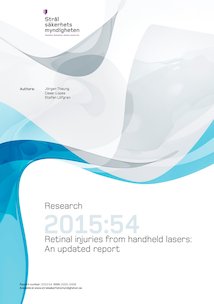Home
A comprehensive resource for safe and responsible laser use

2015:54 Retinal injuries from handheld lasers: An updated report
Research published by the Strål Säkerhets Myndigheten (SSM - the Swedish Radiation Safety Authority)
This English-language study is a 2015 survey of 47 reported laser pointer injury cases since the previous 2013 survey was published. In addition to listing the 47 cases in the appendix, a key objective of the study is to try and correlate the laser dosage with the injuries that were seen.
As the authors write: “The purpose of this study was to investigate what dose of laser radiation, in terms of intensity and exposure time, may be associated with eye damages. The study has been limited to exposures of laser radiation from commercial handheld lasers. Of particular interest has been to search for data that clarify the dose-response relationships for functional disabilities that persist more than 6 months.”
The authors’ results are as follows: “The study shows that long-term vision loss can occur as a result of exposure from freely available handheld lasers at close range. The injury may occur before a normal person is able to respond by closing the eyelid. A minor such damage is transient within a few days. It is also likely that such a visible injury to the retina becomes functional, i.e. prevents reading skills. The use of RiskRatio is introduced, which describes how many times the actual exposure exceeded the exposure limits. Also, a comparison with severity of injury is made.”
Major findings
“In the previous [2013] SSM report we analysed 34 cases and only a few of them had confirmed retinal injuries. In this report the number of cases with confirmed retinal injuries have increased [an additional 47 cases are described in the appendix]. If the availability of the handheld lasers continues to increase, along with higher optical power and lower cost, we expect that the number of severe eye injuries will continue to grow. Also, the distance from which the lasers can be used to disrupt various societal functions, such as air traffic (pilots) and policing will also increase.”
“Almost all the reported cases involve young children and teenagers. There is also a huge overrepresentation by males. Often the lasers are sold as toys and purchased by a relative as a gift to a child.”
“Earlier reports originated almost exclusively from developed countries. This situation has now changed and more and more reports originate from developing countries. The problem is worldwide and hence there is a need to educate and inform the societies of this danger.”
Chapter 4, entitled “Evolution and repair of retinal damage,” explains how damage progresses day by day, damage mechanisms, and the eye’s natural repair mechanisms.
In the previous 2013 report the authors identified six areas for future research:
- National database - a reporting scheme to capture vital information about accidents
- Photochemical effects (in addition to well-known thermal effects)
- Effects of visual aids such as glasses
- Treatment of laser pointer retinal damage
- Secondary injuries - any traffic accidents or other “situations that can result in multiple casualties”
- Long-term or permanent functional deficit which can be detected by advanced instruments
For the 2015 report, they added one more area:
- Infrared radiation in handheld lasers that use intermediate IR to generate visible light. Poorly designed, inexpensive laser pointers may allow relatively high powers of IR.
Conclusion
The following is the authors’ conclusion:
“The main focus in this report is the misuse of handheld lasers leading to eye injuries. The energy emitted by the handheld lasers has increased over the years and is expected to continue to do so. It is therefore not a surprise that an increase in the severity of the injuries was found.”
“We have summarized the medical case histories of retinal injuries caused by commercially available handheld lasers during the recent few years, thus updating our previous SSM report (Löfgren et al. 2013). Children, mostly young males, still dominate among the cases and we see an increase in reported cases with severe retinal injury. The increasing occurrence of visible retinal damage together with significant functional loss might be one of the reasons why ophthalmologists tend to publish more details of the injuries.”
“There is still a lack of data on the exposures, especially regarding the true power of the lasers. In most cases, no optical power measurements were made with the handheld lasers that were apprehended. True exposure duration is also an important parameter that is lacking in many cases. Even when the laser exposure was reported to last for several seconds, it may have been reduced by aversion responses.”
“Eight of the 47 cases were described with sufficient data to be included in an analysis of the estimated laser exposure. We examined how much the actual exposure in each case exceeded the exposure limits by calculating the ratio of the two (“Risk Ratio”, RR). Four cases showed RR values higher than 100, and the highest estimated exposure among the eight cases was 344 times the safety limit. The RR data was also compared to the eye injuries using a grading scale presented by the European Union. Visual acuity data in the case reports were used to indicate the functional outcome after laser exposure. Most of the cases were in between grade 2 and 3, where grade 3 means: Partial loss of sight. Permanent loss of sight (one eye).”
“In addition to our previously proposed topics for future research we have added our interest for investigating to what magnitude the leakage of near-infrared radiation in green lasers can influence the relative risk (RR).”
From 2015:54 Retinal injuries from handheld lasers: An updated report, by Jörgen Thaung, Cesar Lopes and Stefan Löfgren. Published by Strål Säkerhets Myndigheten (SSM - the Swedish Radiation Safety Authority), December 2015. Report number: 2015:54. ISSN: 2000-0456
